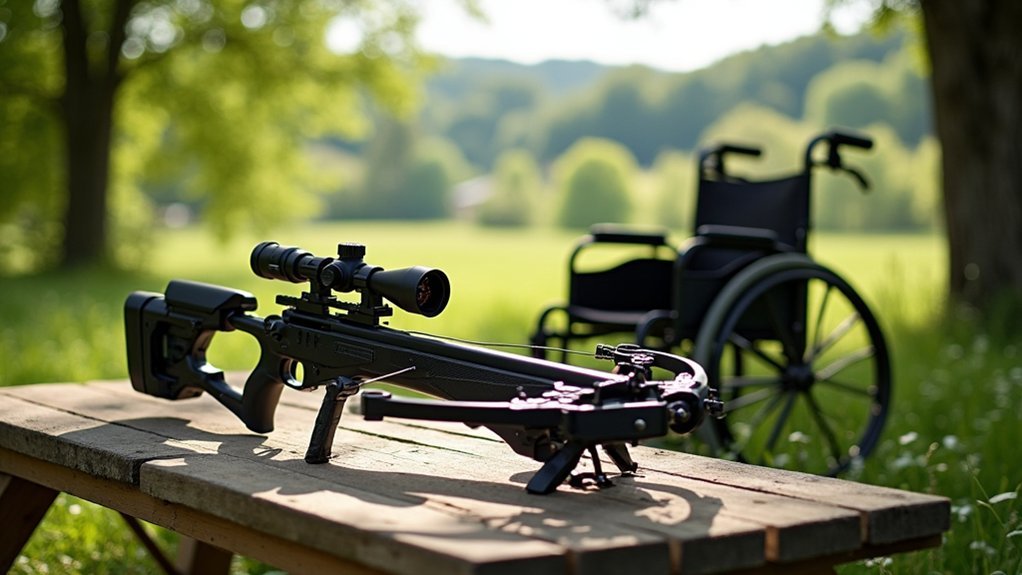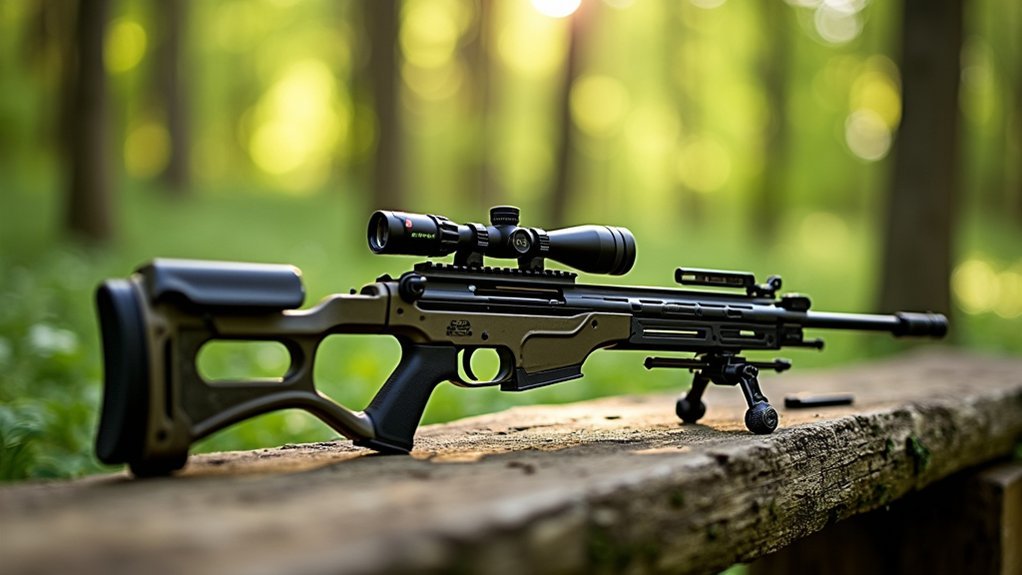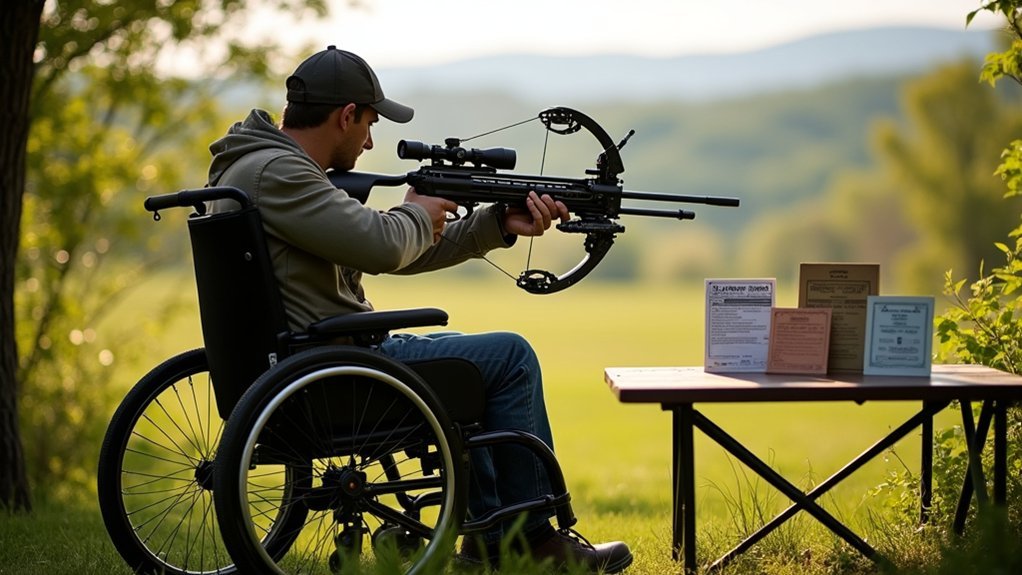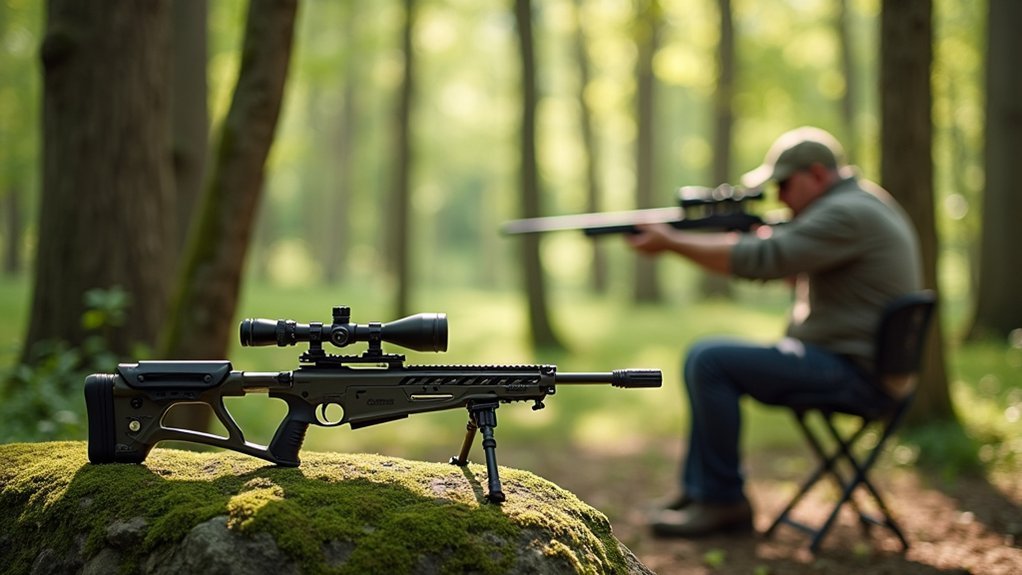For limited mobility hunting, you’ll find TenPoint crossbows with the ACUslide system excellent for safe de-cocking from seated positions. Reverse-draw models offer better weight distribution, while Barnett Whitetail Hunter II provides a lightweight frame reducing fatigue. Look for adaptive features like crank cocking devices, tripod mounts, and one-handed operation capabilities. The Wicked Ridge M370 weighs just 5.8 pounds but delivers 370 FPS. Our complete guide covers everything from equipment specifications to special permit requirements.
Top Crossbow Models for Wheelchair and Seated Hunters

When selecting a crossbow for wheelchair or seated hunting, maneuverability and ease of operation become paramount considerations.
The TenPoint Crossbows series excels with their ACUslide system, allowing safe cocking and de-cocking with minimal effort—ideal for hunters with upper body limitations.
For maximum maneuverability in confined spaces, consider the Turbo S1 with its narrower profile that works well from a seated position. Remember that crossbows were originally designed specifically for disabled hunters who couldn’t use traditional bows.
The Reverse-Draw style crossbows shift weight distribution toward your body, making them easier to shoulder and handle.
The Barnett Whitetail Hunter II offers a lightweight frame that reduces fatigue during extended hunting sessions, while the Excalibur models feature user-friendly hand cranks for easier cocking.
Look for models with pre-mounted stabilizers to enhance aim stability from a seated position.
Essential Adaptive Features and Accessories for Mobility-Limited Archers
Successful adaptive crossbow hunting depends heavily on specialized equipment designed to overcome mobility limitations.
Specialized adaptive equipment transforms crossbow hunting possibilities, eliminating mobility barriers through thoughtful design and targeted modifications.
You’ll find that adaptive crossbows with easier draw mechanisms and trigger assist systems require minimal force while maximizing accuracy.
Consider investing in stability enhancements like tripod mounts or adjustable supports that accommodate your specific needs.
These accessories eliminate tremors and provide consistent positioning from your wheelchair or seated position.
For improved targeting, digital scopes and smart sights offer real-time displays that compensate for visual impairments and environmental conditions.
Safety features such as automated locks and emergency release mechanisms guarantee your protection during hunts.
Don’t overlook the importance of community resources—training workshops and modification support programs can help you customize your equipment while connecting you with fellow adaptive hunters who share valuable experience.
Products like the BT100 Bite Trigger mechanism enable hands-free operation for hunters with severe upper limb limitations.
Lightweight Options for Hunters With Strength Limitations

Lightweight crossbows revolutionize hunting opportunities for those with physical challenges, offering both comfort and practicality in the field.
Models like the Wicked Ridge M370 weigh just 5.8 pounds while delivering impressive 370 FPS velocity, proving you don’t need to sacrifice performance for maneuverability.
You’ll find built-in cocking devices such as ACUdraw that considerably reduce the strength required to prepare your shot.
Compact designs featuring narrower profiles and balanced weight distribution, like Barnett’s Hyper Raptor with pivoting limb pockets, enhance your ability to navigate tight hunting spaces.
The TRX 26’s ultra-compact design provides exceptional portability at just 26.5 inches in length while still delivering speeds up to 460 fps.
These advanced crossbows combine reduced draw weights with high kinetic energy, ensuring you maintain hunting effectiveness without excessive physical strain.
The integration of carbon fiber materials and ergonomic grips further improves handling while maintaining the durability needed for various hunting environments.
One-Handed Operation Crossbows and Mounting Systems
For hunters with limited arm mobility or strength, one-handed operation crossbows represent a game-changing innovation in adaptive hunting equipment.
Pistol crossbows offer compact, lightweight designs with self-cocking mechanisms that require minimal effort to operate.
You’ll find these specialized crossbows equipped with tactical handles for improved grip stability and rail systems that accommodate scopes and red dot sights to enhance your accuracy.
TenPoint’s focus on user-friendly safety features makes their crossbows an excellent option for hunters with mobility challenges.
Many models feature folding stocks and stirrup adaptations specifically designed for one-handed loading.
Safety remains paramount with automatic safety latches and silent tensioners that prevent accidental discharge.
Though typically less powerful than traditional crossbows, these one-handed models deliver impressive precision through match-grade triggers and advanced cam designs.
Their collapsible frames and weights as low as 3 pounds guarantee you can easily transport and maneuver your equipment in various hunting scenarios.
Regulatory Considerations and Permits for Adaptive Crossbow Hunting

While disability-focused adaptations open doors for hunters with limited mobility, traversing the complex regulatory landscape of crossbow hunting remains equally important. You’ll need to understand your state’s specific requirements for disabled hunter permits, which typically require medical certification to validate your status. States like Alaska and Hawaii require special permits for disabled hunters wishing to use crossbows during archery season.
| State Type | Permit Requirements | Equipment Specifications |
|---|---|---|
| Fully Permissive | No special permit needed | Standard draw weight (85-125 lbs) |
| Partially Restrictive | Medical certification | Minimum bolt length (14-16″) |
| Seasonally Restrictive | Valid during specific seasons | Broadhead requirements |
| Age-Restricted | Minimum age requirements | Scope restrictions |
| Disability-Only | Doctor’s verification required | Adaptive equipment allowed |
Equipment regulations vary greatly between states, with requirements for draw weights (90-125 pounds) and bolt lengths (14-16 inches). Many states waive fees or offer simplified processes for disabled hunters, encouraging inclusive hunting opportunities.
Frequently Asked Questions
How Do Limited Mobility Hunters Safely Transport Crossbows to Hunting Locations?
You’ll need to transport your crossbow unloaded in a protective case. Use vehicle racks, shoulder slings, or carts for stability. Always secure it properly and follow state regulations for public land travel.
Can Crossbows Be Effectively Used in Different Weather Conditions by Disabled Hunters?
Yes, you’ll find crossbows perform reliably across various weather conditions. They’re water-resistant in rain, maintain consistency in cold temperatures, and handle well in heat. Most models include adaptive features for disabled hunters’ specific needs.
What Is the Learning Curve for a Mobility-Limited Beginner Using Crossbows?
You’ll find crossbows have a gentle learning curve. They’re easier to master than traditional bows, requiring less physical effort. With proper guidance on safety protocols, you’ll become proficient after consistent, short practice sessions.
How Does Limited Mobility Affect Shot Accuracy and Effective Hunting Range?
Your limited mobility can reduce stability, affecting accuracy. However, using a crossbow’s built-in support systems and proper shooting aids, you’ll still maintain effective hunting range within the typical 40-yard kill zone.
Are There Disabled Hunter-Specific Communities for Shared Crossbow Hunting Experiences?
Yes, you’ll find numerous disabled hunter communities online and locally that share crossbow experiences, offer mentorship programs, host inclusive events, and provide educational resources specifically tailored to hunters with mobility challenges.
In Summary
You’ve got plenty of crossbow options despite mobility challenges. Choose models with cranking mechanisms, adjustable stocks, and lighter draw weights to match your abilities. Don’t forget to explore mounting systems and adaptive accessories that’ll transform your hunting experience. Check your state’s regulations for special permits, and connect with organizations serving disabled hunters for additional support. With the right equipment, you’ll enjoy successful, fulfilling hunts for years to come.





Leave a Reply